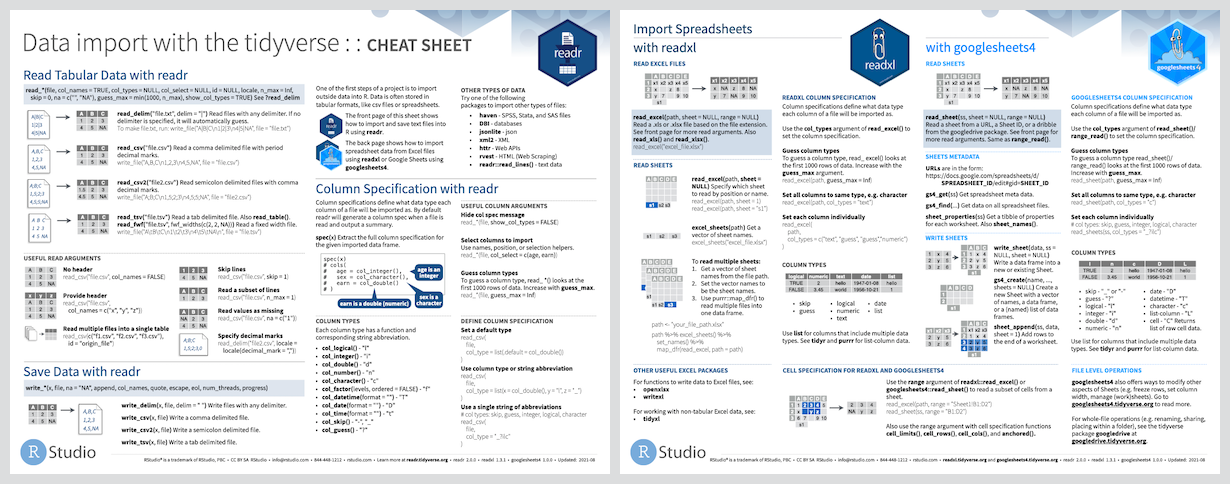https://github.com/tidyverse/googlesheets4
Google Spreadsheets R API (reboot of the googlesheets package)
https://github.com/tidyverse/googlesheets4
google-drive google-sheets r spreadsheet
Last synced: 7 months ago
JSON representation
Google Spreadsheets R API (reboot of the googlesheets package)
- Host: GitHub
- URL: https://github.com/tidyverse/googlesheets4
- Owner: tidyverse
- License: other
- Created: 2017-04-28T02:03:33.000Z (over 8 years ago)
- Default Branch: main
- Last Pushed: 2024-10-29T11:19:22.000Z (about 1 year ago)
- Last Synced: 2024-10-29T13:18:52.908Z (about 1 year ago)
- Topics: google-drive, google-sheets, r, spreadsheet
- Language: R
- Homepage: https://googlesheets4.tidyverse.org
- Size: 28.3 MB
- Stars: 359
- Watchers: 24
- Forks: 51
- Open Issues: 35
-
Metadata Files:
- Readme: README.Rmd
- Changelog: NEWS.md
- Contributing: .github/CONTRIBUTING.md
- License: LICENSE
- Code of conduct: .github/CODE_OF_CONDUCT.md
- Support: .github/SUPPORT.md
Awesome Lists containing this project
- jimsghstars - tidyverse/googlesheets4 - Google Spreadsheets R API (reboot of the googlesheets package) (R)
- awesome-shiny-extensions - googlesheets4 - R interface to Google Sheets via the Sheets API v4. (Backend / G Suite Integration)
README
---
output: github_document
---
```{r setup, include = FALSE}
can_decrypt <- gargle::secret_has_key("GOOGLESHEETS4_KEY")
knitr::opts_chunk$set(
collapse = TRUE,
comment = "#>",
error = TRUE,
fig.path = "man/figures/README-",
out.width = "100%",
purl = can_decrypt,
eval = can_decrypt
)
options(tibble.print_min = 5L, tibble.print_max = 5L)
```
```{r eval = !can_decrypt, echo = FALSE, comment = NA}
message("No token available. Code chunks will not be evaluated.")
```
```{r readme-auth, include = FALSE}
googlesheets4:::gs4_auth_docs()
```
[](https://CRAN.R-project.org/package=googlesheets4)
[](https://github.com/tidyverse/googlesheets4/actions/workflows/R-CMD-check.yaml)
[](https://app.codecov.io/gh/tidyverse/googlesheets4?branch=main)
## Overview
googlesheets4 provides an R interface to [Google Sheets](https://docs.google.com/spreadsheets/) via the [Sheets API v4](https://developers.google.com/sheets/api/). It is a reboot of an earlier package called [googlesheets](https://github.com/jennybc/googlesheets#readme).
*Why **4**? Why googlesheets**4**? Did I miss googlesheets1 through 3? No. The idea is to name the package after the corresponding version of the Sheets API. In hindsight, the original googlesheets should have been googlesheets**3**.*
## Installation
You can install the released version of googlesheets4 from [CRAN](https://CRAN.R-project.org) with:
```{r, eval = FALSE}
install.packages("googlesheets4")
```
And the development version from [GitHub](https://github.com/) with:
```{r eval = FALSE}
#install.packages("pak")
pak::pak("tidyverse/googlesheets4")
```
## Cheatsheet
You can see how to read data with googlesheets4 in the **data import cheatsheet**, which also covers similar functionality in the related packages readr and readxl.
## Auth
googlesheets4 will, by default, help you interact with Sheets as an authenticated Google user. If you don't plan to write Sheets or to read private Sheets, use `gs4_deauth()` to indicate there is no need for a token. See the article [googlesheets4 auth](https://googlesheets4.tidyverse.org/articles/articles/auth.html) for more.
For this overview, we've logged into Google as a specific user in a hidden chunk.
## Attach googlesheets4
```{r}
library(googlesheets4)
```
## Read
The main "read" function of the googlesheets4 package goes by two names, because we want it to make sense in two contexts:
* `read_sheet()` evokes other table-reading functions, like
`readr::read_csv()` and `readxl::read_excel()`. The `sheet` in this case
refers to a Google (spread)Sheet.
* `range_read()` is the right name according to the
[naming convention](https://googlesheets4.tidyverse.org/articles/articles/function-class-names.html)
used throughout the googlesheets4 package.
`read_sheet()` and `range_read()` are synonyms and you can use either one. Here we'll use `read_sheet()`.
googlesheets4 is [pipe-friendly](https://r4ds.had.co.nz/pipes.html) (and reexports `%>%`), but works just fine without the pipe.
Read from
* a URL
* a Sheet ID
* a [`dribble`](https://googledrive.tidyverse.org/reference/dribble.html)
produced by the googledrive package, which can lookup by file name
These all achieve the same thing:
```{r}
# URL
read_sheet("https://docs.google.com/spreadsheets/d/1U6Cf_qEOhiR9AZqTqS3mbMF3zt2db48ZP5v3rkrAEJY/edit#gid=780868077")
# Sheet ID
read_sheet("1U6Cf_qEOhiR9AZqTqS3mbMF3zt2db48ZP5v3rkrAEJY")
# a googledrive "dribble"
googledrive::drive_get("gapminder") %>%
read_sheet()
```
*Note: the only reason we can read a sheet named "gapminder" (the last example) is because the account we're logged in as has a Sheet named "gapminder".*
See the article [Find and Identify Sheets](https://googlesheets4.tidyverse.org/articles/articles/find-identify-sheets.html) for more about specifying the Sheet you want to address. See the article [Read Sheets](https://googlesheets4.tidyverse.org/articles/articles/find-identify-sheets.html) for more about reading from specific sheets or ranges, setting column type, and getting low-level cell data.
## Write
`gs4_create()` creates a brand new Google Sheet and can optionally send some initial data.
```{r}
(ss <- gs4_create("fluffy-bunny", sheets = list(flowers = head(iris))))
```
`sheet_write()` (over)writes a whole data frame into a (work)sheet within a (spread)Sheet.
```{r}
head(mtcars) %>%
sheet_write(ss, sheet = "autos")
ss
```
`sheet_append()`, `range_write()`, `range_flood()`, and `range_clear()` are more
specialized writing functions. See the article [Write Sheets](https://googlesheets4.tidyverse.org/articles/articles/write-sheets.html) for more about writing to Sheets.
```{r include = FALSE}
googledrive::drive_trash(ss)
```
## Where to learn more
[Get started](https://googlesheets4.tidyverse.org/articles/googlesheets4.html) is a more extensive general introduction to googlesheets4.
Browse the [articles index](https://googlesheets4.tidyverse.org/articles/index.html) to find articles that cover various topics in more depth.
See the [function index](https://googlesheets4.tidyverse.org/reference/index.html) for an organized, exhaustive listing.
## Contributing
If you'd like to contribute to the development of googlesheets4, please read [these guidelines](https://googlesheets4.tidyverse.org/CONTRIBUTING.html).
Please note that the googlesheets4 project is released with a [Contributor Code of Conduct](https://googlesheets4.tidyverse.org/CODE_OF_CONDUCT.html). By contributing to this project, you agree to abide by its terms.
## Privacy
[Privacy policy](https://www.tidyverse.org/google_privacy_policy)
## Context
googlesheets4 draws on and complements / emulates other packages in the tidyverse:
* [googlesheets](https://cran.r-project.org/package=googlesheets) is the package that googlesheets4 replaces. Main improvements in googlesheets4: (1) wraps the current, most modern Sheets API; (2) leaves all "whole file"
operations to googledrive; and (3) uses shared infrastructure for auth and more, from the gargle package. The v3 API wrapped by googlesheets is deprecated. [Starting in April/May 2020](https://workspace.google.com/blog/product-announcements/migrate-your-apps-use-latest-sheets-api),
features will gradually be disabled and it's anticipated the API will fully
shutdown in September 2020. At that point, the original googlesheets
package must be retired.
* [googledrive](https://googledrive.tidyverse.org) provides a fully-featured interface to the Google Drive API. Any "whole file" operations can be accomplished with googledrive: upload or download or update a spreadsheet, copy, rename, move, change permission, delete, etc. googledrive supports Team Drives.
* [readxl](https://readxl.tidyverse.org) is the tidyverse package for reading Excel files (xls or xlsx) into an R data frame. googlesheets4 takes cues from parts of the readxl interface, especially around specifying which cells to read.
* [readr](https://readr.tidyverse.org) is the tidyverse package for reading delimited files (e.g., csv or tsv) into an R data frame. googlesheets4 takes cues from readr with respect to column type specification.

